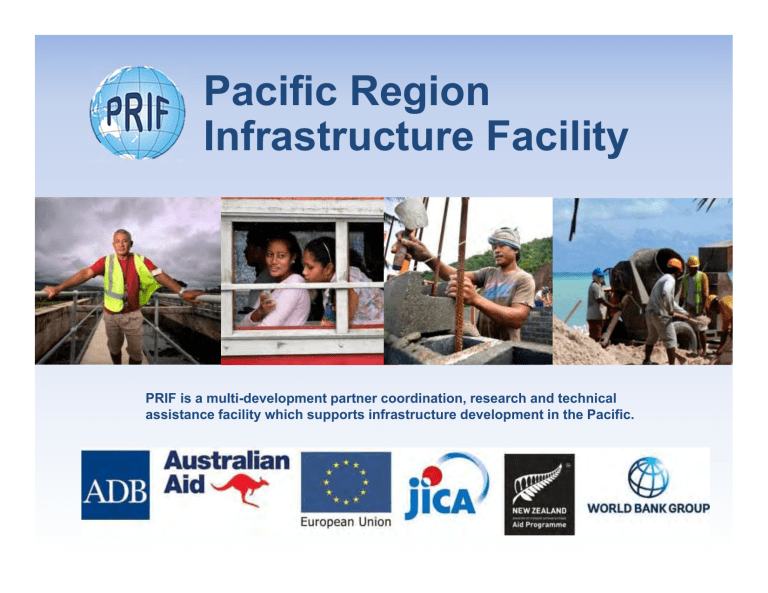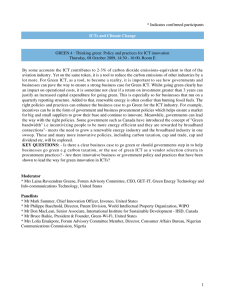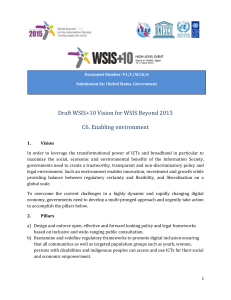Pacific Region Infrastructure Facility

Pacific Region
Infrastructure Facility
PRIF is a multi-development partner coordination, research and technical assistance facility which supports infrastructure development in the Pacific.
1
Launched
by:
Pacific
Region
Infrastructure
Facility
(PRIF)
Coordinated by:
PRIF
ICT
Sector
Working
Group
Study countries
Field visits
Nov.
‐ Dec.
2014
General
observations
• Liberalization of the telecommunications sector has driven competition leading to increased network roll ‐ out and falling prices.
This has led to improved access.
• Average mobile coverage in the countries studied jumped from less than half the population in 2005 to 93 percent in 2014, a basket of mobile calls declined by a third between 2005 and
2014 and penetration of mobile phones in households rose from 49% in 2007 to 93% in 2014.
• Submarine cables have driven an big increase in capacity.
International Internet bandwidth rose from less than 100
Mbit/s to over 1 Gbit/s (excluding Fiji which had already connected to submarine cable in 2000).
• There is considerable scope for widening Internet take ‐ up across the South Pacific and boosting mobile penetration in the
Solomon Islands and Vanuatu.
Mobile coverage
Population covered by 2G (GSM) mobile signal (%)
100%
90%
80%
70%
60%
50%
40%
30%
20%
44%
48%
51%
57%
66%
79%
86% 87%
89%
92%
10%
0%
2005 2006 2007 2008 2009 2010 2011 2012 2013 2014
Huge
increase
in
access
to
mobile
phones
100
90
80
70
60
50
40
30
20
35
10
0
2005
42
2006
Households with a mobile telephone (%)
49
57
67
71
75
2007 2008 2009 2010
Fiji, Samoa & Tonga > 95%
2011
79
83
2012 2013
Mobile
broadband
subscriptions
Despite recent introduction mobile broadband already outnumbers fixed broadband in the South Pacific
Source: Adapted from World Bank and GSMA.
Submarine
cables
Planned
ICT
&
Agriculture
Fishery
&
Forestry
• The agriculture, fi shing & forestry sector could bene fi t from ICT ‐ enabled services in several areas.
• Information services could be provided through SMS or smartphone apps on market prices, disease outbreak, agricultural or fishing specific weather forecasts.
• Bene fi ts accrue from access to additional markets, enhanced pricing information for inputs and outputs and better production through information about improved techniques and minimizing impact of diseases and pests.
ICT
&
Tourism
• Tourism is an important contributor to most South
Pacific economies
• ICTs help to market accommodations, etc.
which could attract more tourists & generate income for SMEs
• ICTs generates revenue for mobile operators through roaming charges and purchase of local SIM cards
ICT
&
Government
ICTs improve government processes and are a prerequisite for enabling web ‐ based or mobile ‐ based public service delivery.
This makes the public administration more ef fi cient, increases transparency of procedures and saves time and money for citizens by reducing the need to travel to government of fi ces.
ICT
&
Financial
Services
• Mobile technology can play a key role in supporting and enabling fi nancial services.
These include mobile money and mobile remittances, crucial to the fi nancially excluded.
• This is particularly relevant in the Paci fi c region, which, according to the GSMA is "...
one of the least banked areas on the planet with nearly 80% of people in the region with no access to formal fi nancial services.
ICT
&
Health
• ICT affects the health sector in various ways.
It improves internal processes, increasing efficiency and lowering costs.
• Mobile phones can be used to alert patients about taking medicine, online health information can be made available to citizens and diagnostic information can be transmitted over broadband networks for experts to analyze.
ICT
&
Education
• ICTs enable e ‐ learning, online educational content and videoconferences of lectures among other things.
• Low cost computing devices make dissemination of hardware to students more cost ‐ effective.
• Wider access to computers and the Internet in schools can improve digital literacy and prepare students for eventual employment in the ICT sector.
Summary
• Massive increase in mobile penetration & huge increase in social networking
• Internet access starting to improve (already quite high in Fiji)
• All countries except Solomon Islands now connected to submarine cable
• Direct contribution of communications sector to GDP growth.
Indirect contribution not possible to measure due to lack of quarterly data
• Penetration strongly linked to income
• All countries run trade deficit in computer & information services
• Impact of mobile money mainly limited to lowering cost of remittances rather than widening financial inclusion except Solomon Islands where mobile banking has been significant
• Limited online public services but where available some anecdotal evidence suggests impact (Tonga business registration, Solomon Islands voter registration)
• Few impacts observed in agriculture, health or education to date— potential for development
Possible
Interventions
• Improving data collection & monitoring ICT sector
• Strengthening competition
• Leveraging international connectivity
• Fostering e ‐ learning and educational content creation
• Supporting ICT enabled agricultural services
• Stimulating e ‐ Health
• Using ICTs for public service delivery (e ‐ government)
• Boosting tourism impacts
• Making ICT access universal



